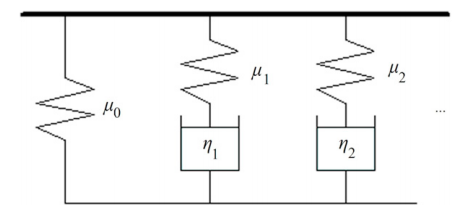A wide range of surface acoustic wave (SAW) sensors for chemical and biochemical sensing applications has been reported. Love wave is a kind of SAWs with particle vibration only (at least dominantly) in the shear horizontal direction. To achieve better sensor performances such as higher mass sensitivity and less TCF, polymeric guiding layer is often adopted. Due to the large viscosity, the experimental maximum sensitivity is less than the theoretically predicted value. Thus, a theoretical model for analyzing Love wave devices with a viscoelastic guiding layer should be urgently developed.
This research develops a theoretical method for analyzing Love waves in a structure with a viscoelastic guiding layer bounded on a piezoelectric substrate. It briefly reviews the theoretical model for piezoelectric Love waves propagating in an elastic–piezoelectric structure. The dispersion equations for an electrically open or shorted surface are derived. As well, a Maxwell–Weichert (see Figure 1) model is introduced to describe the complex shear stiffness introduced by the viscosity of a polymeric material. The changes in shear stiffness with the relaxation time and the frequency are then discussed. When the viscosity of the guiding layer is introduced, the propagation factor becomes a complex number, whose real part is related to the propagation velocity and imaginary part is related to the propagation attenuation. The dispersion equation is complicated, and a Newton iteration method is adopted to solve the equation.
Numerical calculations are presented for a Love wave device with a viscoelastic guiding layer on a piezoelectric substrate. The results indicate that the propagation velocity is mainly decided by the shear stiffness of the guiding layer. And the propagation loss is proportional to the viscosity. Moreover, the electromechanical coupling coefficient is not affected by the viscosity.
A Love wave delay line was fabricated on an ST-90˚ X quartz substrate and overlaid with various thicknesses of SU-8 guiding layers. The viscosity of the guiding layer produced a tail-raising for the Love wave velocity, and this phenomenon was verified by the experimental results. Furthermore, the insertion loss of Love wave delay lines was calculated, and the calculations agreed well with the measured results. The method and the results presented in this study are beneficial to the design of Love wave sensors with viscoelastic guiding layers.

Figure 1. Schematic of the Maxwell–Weichert model for a linear viscoelastic material. The first branch ensures that the modeled material does not display any permanent deformation. Each (Maxwell) branch consists of a linear spring and a dashpot (Image by LIU).
This research named “Properties of Love Waves in a Piezoelectric Layered Structure with a Viscoelastic Guiding Layer” has been released in Smart Materials and Structures (Vol. 22, No. 12, December 2013) online at stacks.iop.org/SMS/22/125034.
Contact:
LIU Jiansheng
Institute of Acoustics, Chinese Academy of Sciences, Beijing 100190, China
Email: liujs98@hotmail.com or liujiansheng@mail.ioa.ac.cn


